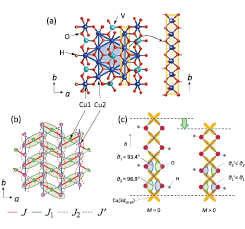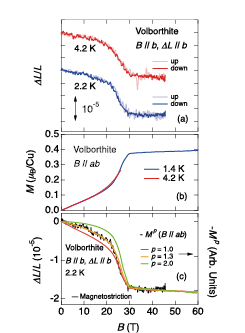Short-Range Spin Correlations in a Quantum Magnet Detected Through Magnetoelasctic Couplings in a Kagome Quantum Spin Lattice
Y. H. Matsuda, Takeyama, and Hiroi Groups
In case of quantum magnets, magnetostriction can be a unique measure of short-range spin correlations. The spin components perpendicular to the external magnetic field is inherent in the local spin correlation. In quantum magnets, magnetostriction measurement is a direct measure of the local spin correlation.

Fig. 1. (a) The lattice model of volborthite (b) Coupled trimer model for volborthite (c) A schematic drawing of the pantograph-like lattice modification of the magnetostriction in the crystallographic b axis.

Fig. 2. (a) Magnetostriction curves of volborthite (b) Magnetization curves of volborthite (c) A comparison of the curves of magnetostriction and magnetization indicating a peculiar dependence of ΔL~M1.3.
We have recently developed a high-speed 100 MHz magnetostriction measurement system utilizing the fiber Bragg grating techniques [1] for the use in the µ-seconds pulsed magnetic fields beyond 100 T (megagauss region) and 1000 T (kilo-Tesla region) [2]. We found later that the system can also be used in the milli-seconds pulsed magnetic fields below 100 T with an appreciable high-resolution of ΔL/L ~ 10-6 [3]. Using the developed instrument, we have conducted the magnetostriction measurement for the two-dimensional quantum magnet of volborthite [4].
Volborthite (Cu3V2O7(OH)2 · 2H2O) is a fascinating example of a highly frustrated quantum magnet. In its magnetic layer, Cu ions possessing spin-1/2 moments form a deformed kagome lattice as schematically shown in Fig. 1(a). Owing to the lattice deformation, the anisotropic microscopic spin model based on coupled trimers as shown in Fig. 1(b) has recently been proposed, that now attracts attention as it provides a mechanism for a field-induced spin nematic phase adjacent to the 1/3 magnetization plateau. In the spin nematic phase, spin directors that break the in-plane rotational symmetry are formed as a result of the Bose-Einstein condensation of bimagnon excitations. The rotational symmetry breakings take place in the lateral direction of the spin space, which thus implies that the measurement of the lateral spin-correlation in this magnet is quite important.
Figures. 2(a)-(c) shows the result of the magnetostriction measurement. A negative magnetostriction and a peculiar dependence of the magnetostriction on the magnetization as ΔL ~ M1.3 are observed. The negative magnetostriction in the crystallographic b axis is understandable with a pantograph-like lattice modification. As shown in Fig. 1(c), the Cu-O-Cu chain in the b axis is responsible for the ferromagnetic superexchange interaction in the coupled trimer model. The closer the bond angles to 90 degree, the stronger the ferromagnetic exchange couplings due to the Kanamori-Goodenough rule, where, as a result, the bond length in the b axis is elongated. The story is supported by a tentative DFT+U calculations [4]. On the other hand, the peculiar dependence of the magnetostriction on the magnetization can also qualitatively understood as a manifestation of the short-range spin correlation within the exchange striction model. In the exact-diagonalization approach, it becomes clear that the spin-correlation is indeed in between the M1.0 and M2.0 and close to M1.3. For further studies in the future, the spin-nematicity may show abnormal magnetoelastic response at even lower magnetic fields at around 28 T. Another possible study is the measurement beyond 100 T. The end of the 1/3 magnetization plateau may be detected in the magnetostriction measurement.
References
- [1] A. Ikeda, T. Nomura, Y. H. Matsuda, S. Tani, Y. Kobayashi, H. Watanabe and K. Sato, Rev. Sci. Instrum. 88, 083906 (2017).
- [2] D. Nakamura, A. Ikeda, H. Sawabe, Y. H. Matsuda, and S. Takeyama, Rev. Sci. Instrum. 89, 095106 (2018)
- [3] A. Ikeda, Y. H. Matsuda, and H. Tsuda, Rev. Sci. Instrum. 89, 096103 (2018).
- [4] A. Ikeda, S. Furukawa, O. Janson, Y. H. Matsuda, S, Takeyama, T. Yajima, Z. Hiroi, and H. Ishikawa, Phys. Rev. B 99, 140412(R) (2019).
